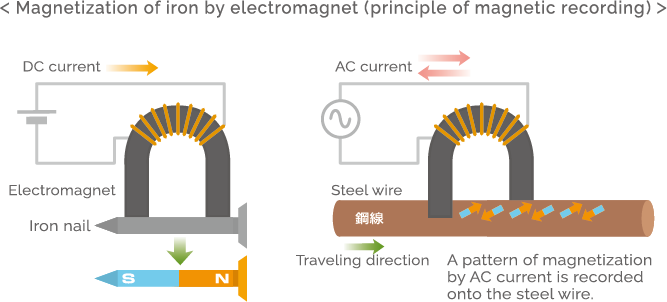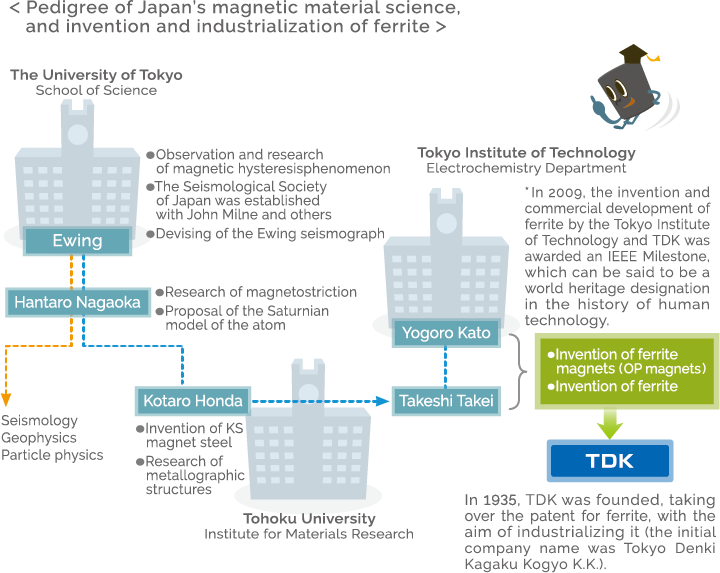Ferrite World
Vol. 5 High-frequency ferrite––material that has helped the development of wireless technologies

Soft magnetic materials invented successively in the first half of the 20th century
The cultivation of spirit or personality is called “touya” in Japanese. This word originates from a pottery (ceramics) making process in which clay is baked hard and a metallurgy process by which metal is extracted from ore. The first half of the 20th century was, so to speak, a “touya” period for magnetic materials. This was because good new metallic and ceramic materials were developed successively during this period.
In the middle of 19th century, when transformers, motors, and electricity generators started to be used, there was increasing demand for soft magnetic materials, which have the property to quickly follow changes in AC magnetic fields (high magnetic permeability), for use in the cores of those devices. At that time, soft iron (iron made similar to pure iron by reducing carbon) was almost the only soft magnetic material, but in 1900, silicon steel (iron-silicon alloy), which has twice the magnetic permeability of soft iron, was invented in the UK. Also, in 1921, permalloy, a nickel-iron alloy, was invented in the US. Permalloy was named because of being a high-permeability alloy. Permalloy has much higher magnetic permeability than silicon steel, but uses costly nickel. Thus, a material called Sendust, which is an alloy of iron, aluminum, and silicon, was invented at Tohoku University’s Institute for Materials Research (in 1937). Sendust alloy is made into powder (dust), and hardened by pressing into cores to be used. Cores manufactured by such a method are called dust cores (powder magnetic cores).
However, these soft magnetic materials have a fundamental problem. Since they are metals, they have low electrical resistance and cause a large amount of heat-generation loss due to eddy current loss under a kilohertz, megahertz, or higher-frequency AC magnetic field. Thus, ferrite (soft ferrite) gained attention as a high-frequency soft magnetic material (invented in 1930). A ferrite core is not a powder magnetic core like a Sendust core but a magnetic ceramic manufactured by molding and sintering powder material. Ceramic is a polycrystal in which numerous fine crystal grains gather. Grain boundaries, which are boundaries between crystal grains, not only show high electrical resistance close to that of insulating material, but also produce various magnetic properties specific to ferrite that cannot be obtained from metals.
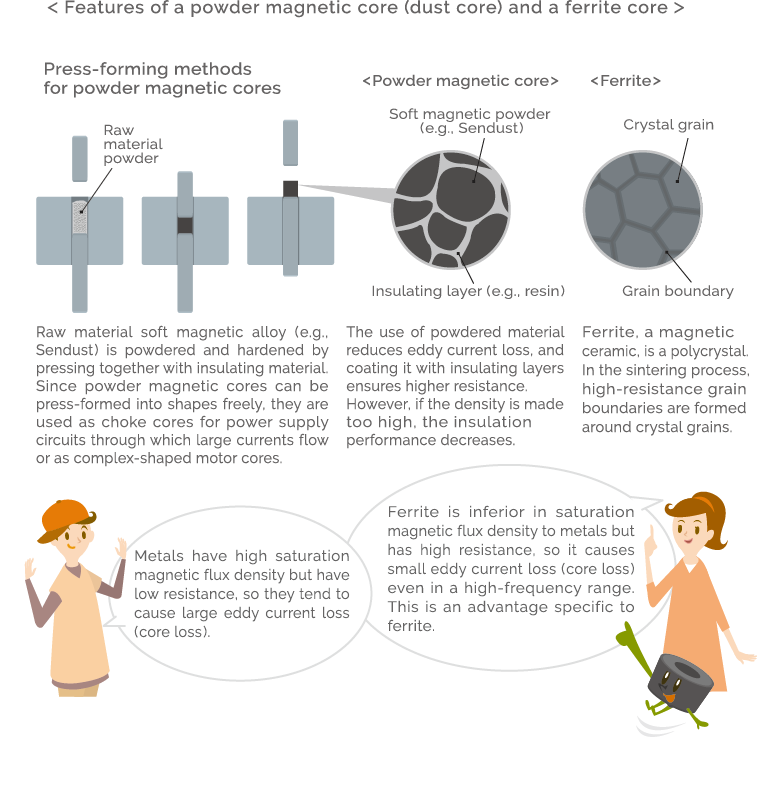
TDK’s ferrite cores that were widely used in “super radios”
In the 1930s, when ferrite was invented, communication and broadcast technologies were progressing toward higher frequency. Let’s look at the history of wireless communication. In primitive wireless telegraph invented by Guglielmo Marconi, radio waves associated with spark discharge were emitted intermittently from an antenna to send signals as dot-and-dash Morse code (information was converted to short signals (dots) and long signals (dashes)). For example, when an electronic lighter is ignited near a radio, a short snapping noise is produced. This is because a noise radio wave is generated during spark discharge. Marconi’s wireless communication is similar to this phenomenon. It was the wireless communication in which noise radio waves were sent as sort of smoke signals. However, interference inevitably occurred in Marconi’s wireless communication in a similar way that the use of smoke signals anywhere confused information. Thus, resonant circuits consisting of a coil and a capacitor (devised by Oliver Lodge in 1898) started to be used as tuning circuits to selectively extract radio waves of a certain frequency.
When the wireless telegraph became widely used, the practical use of wireless telephone arose as the next technological issue. When it came to wireless telephone, continuous high-frequency radio waves (carrier waves) were needed to convey voice currents. The development of equipment to generate them was a very difficult task, and initially, a large high-frequency electricity generator was used to mechanically generate high-frequency waves. The generation of stable high-frequency waves on small equipment was achieved by the invention of an oscillation circuit using a vacuum tube. This was a circuit that gives some part of the output back to the input side as feedback. The feedback circuit allows oscillation at a constant frequency in a similar way that oscillation called audio feedback occurs when a microphone is put close to a loudspeaker. Thus, while the basic technologies for wireless telephone were accumulated, radio broadcast began in the 1920s.
However, primitive radios had low selectivity, and posed the problem that they tend to receive other broadcast radio waves of similar frequencies, causing interference. In order to solve this, a circuit called a superheterodyne was devised, which is still used at the present time in receivers of radios and televisions. It is an ingenious system that first converts the frequencies of broadcast radio waves into a certain intermediate frequency (455 kHz for AM radio broadcast in Japan) using a local oscillation circuit and then demodulate signals (to extract audio signals). In Japan, superheterodyne radios (so-called super radios) became widely used after the Second World War (in 1945). TDK’s ferrite cores were used in large volumes as the cores of intermediate-frequency transformers (IFTs) for the radio receivers.
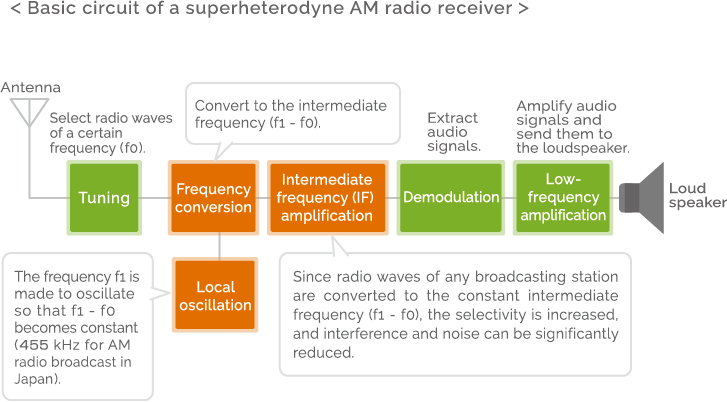
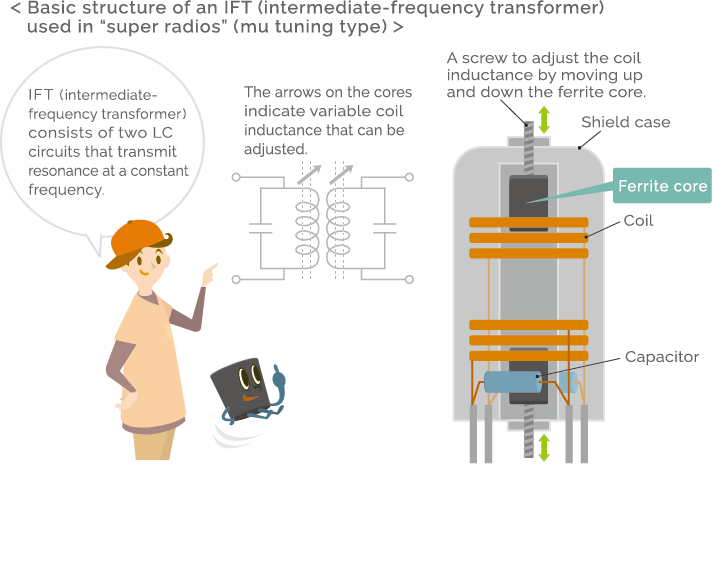
Isolators/circulators in which Faraday rotation is applied using ferrite
There are various types of ferrites, and the ferrites used for the cores of transformers and antennas include MnZn (manganese-zinc)-ferrites and NiZn (nickel-zinc)-ferrites. MnZn-ferrites offer excellent properties in a several-megahertz or lower-frequency band, and NiZn-ferrites are used in a 10-megahertz or higher-frequency band.
For mobile telephones, satellite communication, or the like, microwaves (radio waves with a wavelength of about 1m or less, or a frequency of 300 MHz or higher) are used. The application components of special ferrites used in such a high-frequency range (microwave ferrites such as YIG ferrite) include isolators and circulators.
For example, in a mobile telephone, a single antenna is used to both transmit and receive radio waves, so one-way circuits through which radio waves never flow backward are needed. An isolator is a device that has the function of smoothly passing forward-direction radio waves and absorbing and thereby preventing reverse-direction radio waves caused by reflection, etc. Its principle is a phenomenon called Faraday rotation, which was discovered by Michael Faraday in 1845. When light passes through glass, reflects, and returns to the glass, it passes through the glass in the same way it does first. Faraday, however, found that when light is reflected after being made to pass through glass to which a magnetic field is applied, the reflected light does not pass through the glass. In other words, glass is made into a one-way route for light by applying a magnetic field. This is a phenomenon called Faraday rotation (for details, see No.19 of “The Wonders of Electromagnetism”).
If the light and the glass are replaced with microwave and ferrite, respectively, then the mechanism serves as an isolator, a one-way route for radio waves. An isolator is a small but important component for wireless communications equipment such as mobile phones. Under the same principle, a three-port circulator passes radio waves among the ports only in one direction like a traffic circle in front of a train station. TDK’s circulators are utilized, for example, in microwave relay equipment for base stations.
Circuits of wireless equipment such as radios, televisions, and mobile phones are a collection of many forerunners’ inventions and ideas, and these are embodied by various electronic materials. One of the key technologies that have promoted the development of electronics is materials technology. Ferrite first appeared suddenly in Japan as unusual magnetic material, during the time when magnetic materials were generally regarded as metal materials. However, it was found not unusual at all but a magnetic material that should be referred to as a true product for the age of high frequency.
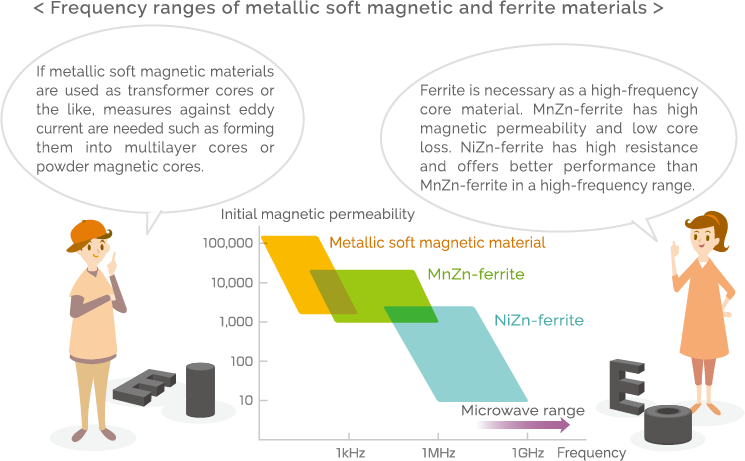
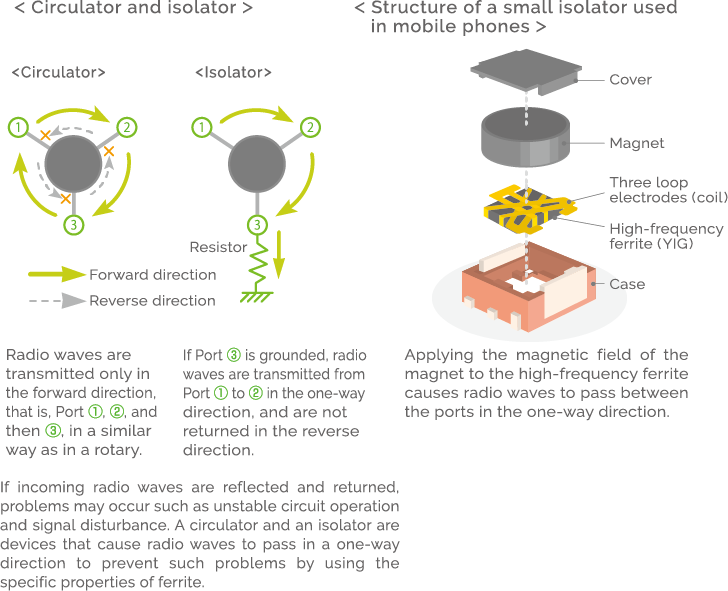
TDK is a comprehensive electronic components manufacturer leading the world in magnetic technology



